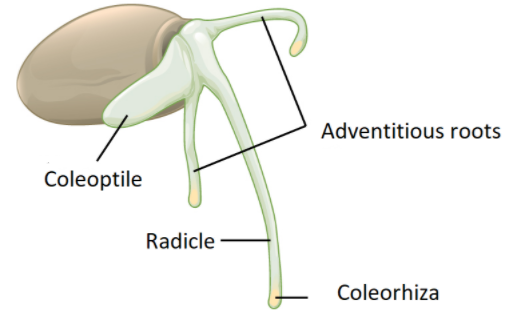
Describe the structure of a monocot seed.
Answer
437.1k+ views
Hint: A monocotyledonous seed has a single cotyledon in it with a thick seed coat and it gets fused with the pericarp. These seeds are endospermic in nature. The cotyledons in the monocot seed are known as scutellum and are supplied with the shoot axis.
Complete answer:
The monocot seed has the outer seed coat and the inner seed coat. Within these layers the embryo is known to occur. This monocot seed is differentiated due to the separate axis. The part of the axis that is present in the decrease phase of the seed is referred to as radical. This part blanketed through the sheath is referred to as coleoptile. The part of the axis that is present in the higher part of the stem is called plumule.
The plumule is covered by a sheath called coleoptile. After the germination of the seed, the water enters into the gap of mycorrhiza and the seed bulges.
This motivates the boom of the seed, in which the stem section of the seed grows from the elongation of the plumule by destroying the layer of coleoptile and the root types from the radicle through the breaking of the coleorhiza. The endosperm is present and located in the internal phase of the seed around the embryo. This is the nutritive layer that provides nutrition for the increase of the embryo; the monocot seed possesses the aleurone layer which is the layer of protein that is existing in between the endosperm and the outer covering of the seed.

Note: The example for the monocot seeds includes the grains like rice, wheat, maize, barley etc., onion, banana, palm, ginger, coconut, garlic, bamboo, Lillie, tulips etc. All of these flora possess solely one cotyledon or the scutellum in the seed of these plants. The dicotyledonous plants possess two cotyledons. For example-Mango.
Complete answer:
The monocot seed has the outer seed coat and the inner seed coat. Within these layers the embryo is known to occur. This monocot seed is differentiated due to the separate axis. The part of the axis that is present in the decrease phase of the seed is referred to as radical. This part blanketed through the sheath is referred to as coleoptile. The part of the axis that is present in the higher part of the stem is called plumule.
The plumule is covered by a sheath called coleoptile. After the germination of the seed, the water enters into the gap of mycorrhiza and the seed bulges.
This motivates the boom of the seed, in which the stem section of the seed grows from the elongation of the plumule by destroying the layer of coleoptile and the root types from the radicle through the breaking of the coleorhiza. The endosperm is present and located in the internal phase of the seed around the embryo. This is the nutritive layer that provides nutrition for the increase of the embryo; the monocot seed possesses the aleurone layer which is the layer of protein that is existing in between the endosperm and the outer covering of the seed.

Note: The example for the monocot seeds includes the grains like rice, wheat, maize, barley etc., onion, banana, palm, ginger, coconut, garlic, bamboo, Lillie, tulips etc. All of these flora possess solely one cotyledon or the scutellum in the seed of these plants. The dicotyledonous plants possess two cotyledons. For example-Mango.
Latest Vedantu courses for you
Grade 11 Science PCM | CBSE | SCHOOL | English
CBSE (2025-26)
School Full course for CBSE students
₹41,848 per year
Recently Updated Pages
Express the following as a fraction and simplify a class 7 maths CBSE

The length and width of a rectangle are in ratio of class 7 maths CBSE

The ratio of the income to the expenditure of a family class 7 maths CBSE

How do you write 025 million in scientific notatio class 7 maths CBSE

How do you convert 295 meters per second to kilometers class 7 maths CBSE

Write the following in Roman numerals 25819 class 7 maths CBSE

Trending doubts
State and prove Bernoullis theorem class 11 physics CBSE

What are Quantum numbers Explain the quantum number class 11 chemistry CBSE

Write the differences between monocot plants and dicot class 11 biology CBSE

1 ton equals to A 100 kg B 1000 kg C 10 kg D 10000 class 11 physics CBSE

State the laws of reflection of light

In northern hemisphere 21st March is called as A Vernal class 11 social science CBSE




